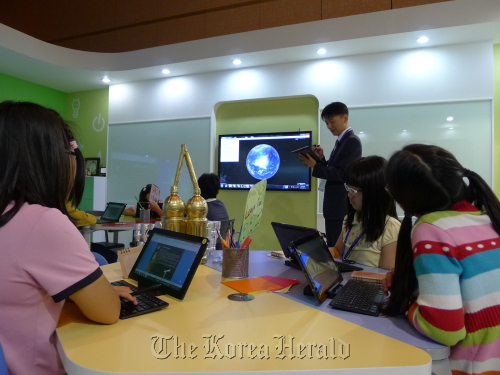GYEONGJU ― An elementary school student scans her ID card at the school gate. Once she steps in, an electronic signal tells her parents and teacher that she is now at school.
The classroom has no wall, but a panel of multi-screens. Tablet computers replace paper textbooks and electronic panels substitute chalkboards in the wireless Internet-powered space.
The state-funded Korea Education Research Information Service is offering a glimpse into what classrooms will look like in the coming years in an exhibition in Gyeongju, North Gyeongsang Province.
The classroom has no wall, but a panel of multi-screens. Tablet computers replace paper textbooks and electronic panels substitute chalkboards in the wireless Internet-powered space.
The state-funded Korea Education Research Information Service is offering a glimpse into what classrooms will look like in the coming years in an exhibition in Gyeongju, North Gyeongsang Province.

The “Smart Class” opened on Monday on the sidelines of the 5th APEC Education Ministerial Meeting.
The exhibition will run during the three-day meeting to showcase teaching and learning scenarios for classrooms of the future in Korea, according to the KERIS.
A smart classroom is one of the key features of the country’s future education. Under the “Smart Education” policy begun in 2011, the Ministry of Education, Science and Technology has developed new education tools, such as digital textbooks and e-learning programs.
Students in some schools are already using tablet PCs and Android technology and the ministry is now working on applying the technology on a wider scale.
“We’ll start to digitalize all textbooks and teaching materials for elementary school from 2015,” said Jang Sang-hyun, a PR manager of KERIS.
He said digital devices in classrooms will fundamentally change the way students learn.
Teachers will use electronic whiteboards and classrooms will have wireless Internet connections. Also, students will be able to access learning materials anytime, anywhere through cloud computing, he explained.
“We believe that the digital technology will transform the lecture-centered classroom into a more interactive-centered classroom, providing more customized learning for each student,” said Jang.
By Oh Kyu-wook (596story@heraldcorp.com)
-
Articles by Korea Herald






![[From the Scene] Monks, Buddhists hail return of remains of Buddhas](http://res.heraldm.com/phpwas/restmb_idxmake.php?idx=644&simg=/content/image/2024/04/19/20240419050617_0.jpg&u=20240419175937)








![[From the Scene] Monks, Buddhists hail return of remains of Buddhas](http://res.heraldm.com/phpwas/restmb_idxmake.php?idx=652&simg=/content/image/2024/04/19/20240419050617_0.jpg&u=20240419175937)

![[KH Explains] Hyundai's full hybrid edge to pay off amid slow transition to pure EVs](http://res.heraldm.com/phpwas/restmb_idxmake.php?idx=652&simg=/content/image/2024/04/18/20240418050645_0.jpg&u=20240419100350)

![[Today’s K-pop] Illit drops debut single remix](http://res.heraldm.com/phpwas/restmb_idxmake.php?idx=642&simg=/content/image/2024/04/19/20240419050612_0.jpg&u=)